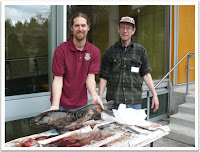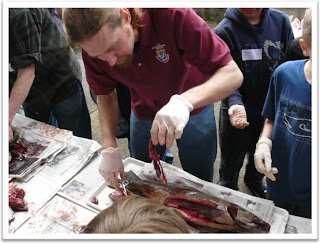Thurston County and Chehalis Basin Students Explore Salmon Anatomy from the Outside – In
Curious minds took full advantage of the opportunity to explore fish anatomy and physiology at the Student GREEN Congress (Thurston County) and Chehalis Basin Education Consortium Student Congress this past March. Every year, participating 4th through 12th grade classrooms gather water quality samples from local watersheds (over 2,000 and 1,500 students involved respectively). Classroom delegates were selected (over 380 and 300 students respectively) to present their findings to both peers and natural resource professionals at these culminating Congress events.
Prior to the event, students signed up for workshops offered by local professionals and community volunteers. These conservation-based courses served as supplemental learning components to the water quality reports presented by the student delegates. Dan Spencer, USFWS fisheries technician and educator, provided two workshops at each event. Joe Jauquet, a local salmon biologist, also provided dissection instruction at the Student Green Congress.
 |
| Dan and Joe with salmon carcass |
Seeing this as a teachable moment, Dan and Joe began by explaining how the salmon that the students were about to dissect were once living creatures. “We need to show respect for these fish. It is amazing how these fish even survived to adulthood. Out of 2,000 to 4,000 eggs, only one or two are typically successful in making this impressive round trip journey.” The children inched closer, their eyes focused on the bodies that lay before them.
 |
| Dan dissecting salmon carcass |
As soon as the excitement settled, Joe began to gingerly dissect the first carcass. “Does anyone know what these are?” Joe asked in almost a whisper. “Gills.” replied a little boy closest to me. “That’s right. And what do we have that are like gills?” “Lungs?” “Correct. Gills extract oxygen from the water like our lungs extract oxygen from the air.”
 |
| Students passing around salmon organs |
Before we knew it, the workshop was over. “This was an awesome session! I am so glad that I signed up for it. I learned so much about fish!” I heard one girl whisper to her friend. “It was gross but awesome!” a young boy exclaimed to his friend. “It was gross-ome!” his friend replied back. I personally could not agree more.
For more information on South Sound GREEN:
http://www.facebook.com/pages/South-Sound-GREEN/232623940759
For more information on the Chehalis Basin Education Consortium:
http://www.crcwater.org/2006/200602cbecinfo.html